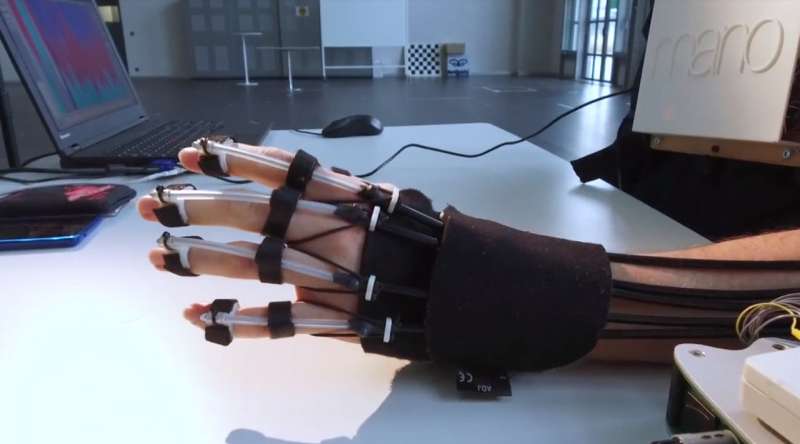Feedback enhances brainwave control of a novel hand-exoskeleton

An extremely lightweight and portable hand exoskeleton may one day help the physically impaired with daily living. These are the hopes of EPFL scientist Luca Randazzo who is developing the exoskeleton with the Defitech Chair in Brain-Machine Interface led by José Millán. The results are published in the January edition of IEEE Robotics and Automation Letters.
Their lab at Campus Biotech in Geneva is equipped with gait machines and commercial exoskeletons for walking assistance, but Randazzo started with the rudiments. "When I arrived at the lab, the first thing I added was a sewing machine so that I could develop wearable devices," he explains.
The exoskeleton is lightweight, portable and adaptable
Easily and quickly strapped to the joints with Velcro, patients are equipped with the hand-exoskeleton in just a few minutes. Metal cables act as soft tendons along the back-side of each finger, leaving the palm free in order to maximize sensations felt by the hand. A chest-pack contains motors that can push and pull on the different cables, flexing the fingers when the cables are pushed and extending them when pulled.
The exoskeleton is adaptable by design, so that the control interface can be chosen according to the residual physical ability of the patient. The control interface can then be chosen from of vast variety of systems, from eye-movement monitoring for the severely paralyzed, to smartphone-based voice interfaces, residual muscular activity of the damaged limb, all the way to reading brainwave activity with a headset.
Unexpected brain signal improves exoskeleton control
The scientists decided to pursue brainwave-control of the exoskeleton via an EEG headset that measures the users' brainwaves as they used the exoskeleton. They found that the hand motions induced by the device elicit brain patterns typical of healthy hand motions. But they also discovered that exoskeleton-induced hand motions combined with a user-driven brain-machine interface lead to peculiar brain patterns that could actually facilitate control of the device.
The part of the brain that controls body movement is called the motor cortex, which in fact is divided into a left- and a right-hand side. The right motor cortex is mostly active during control of the left hand, and vice versa, a property of the nervous system called contralateral control, contra for opposite, lateral for side.
As expected, the scientists observed this contralateral brainwave activity in people who passively received hand motion by the exoskeleton. But they also noticed that, when the subjects were asked to control the hand-exoskeleton with their brainwaves, consistent same-side patterns also emerged in the brainwave data.
In other words, when these people were asked to actively think about moving the exoskeleton, the part of the brain that normally thinks about controlling the opposite hand was also being solicited in the brain.
The scientists believe that this brain activity emerging from the combination of voluntary control and coherent feedback provided by the device could be exploited for improving brain control of these devices.
"This enhanced control of the hand-exoskeleton with brainwave activity is most likely due to higher engagement of subjects facilitated by rich sensory feedback provided by the nature of our exoskeleton," explains Millán. "Feedback is provided by the user's perception of position and movement of the hand, and this proprioception is essential."
So far, the hand-exoskeleton has been tested with patients with disabilities due to strokes and spinal cord injuries. The next steps involve improving the system both for assistive purposes, for performing tasks at home, or even as a tool for rehabilitation.
"The hope is that by combining seamless human-machine interfaces and portable devices, these kinds of systems could enable and promote functional use in meaningful daily tasks," adds Randazzo.


















